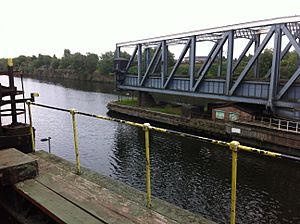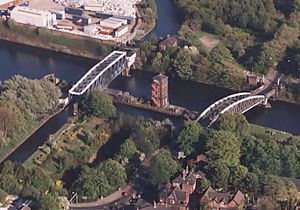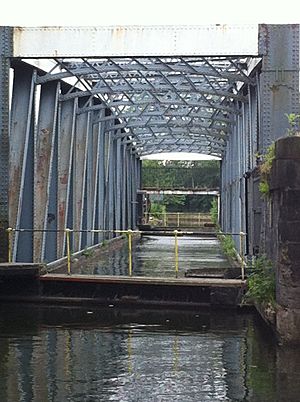Barton Swing Aqueduct facts for kids
Quick facts for kids Barton Swing Aqueduct |
|
|---|---|
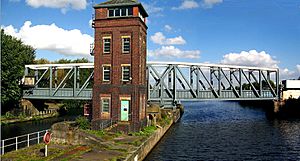
The aqueduct in the closed position
|
|
| OS grid reference | |
| Carries | Bridgewater Canal |
| Crosses | Manchester Ship Canal |
| Locale | Barton upon Irwell |
| Heritage status | Grade II |
| Characteristics | |
| Total length | 330 feet (101 m) |
| Traversable? | Only narrowboats |
| Towpaths | None |
| Number of spans | Two (Central Pivot) |
| History | |
| Designer | Sir Edward Leader Williams |
| Construction end | 1893 |
| Opened | 1894 |
The Barton Swing Aqueduct is a really cool and unique bridge in Barton upon Irwell, Greater Manchester, England. It's special because it moves! This amazing structure carries the Bridgewater Canal right over the top of the much bigger Manchester Ship Canal. Imagine a river flowing over another river, but the top one can swing out of the way!
This clever design lets huge ships pass underneath on the ship canal. At the same time, smaller boats like narrowboats can still cross safely above. It's the only swing aqueduct in the world. It is also a Grade II* listed building, meaning it's a very important historic structure. This aqueduct is considered a fantastic example of Victorian civil engineering. Sir Edward Leader Williams designed it, and Andrew Handyside and Company built it. The swing bridge opened in 1894 and is still used regularly today.
Contents
A Look Back: How It All Started
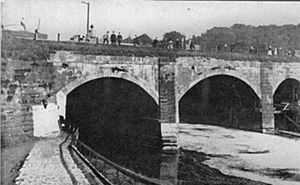
The Barton Swing Aqueduct replaced an older bridge. This older bridge was called the Barton Aqueduct. It was made of stone and crossed the River Irwell. It was finished way back in 1761.
In the 1890s, workers started building the Manchester Ship Canal. This new canal needed to be deep enough for very large ships. The old aqueduct was too low for these big ships to pass under. So, a new solution was needed.
Engineers thought about using a double lock flight. This would have meant boats going up and down. But this idea was rejected. It would have wasted too much water from the Bridgewater Canal above.
Sir Edward Leader Williams designed the new aqueduct. He was the main engineer for the Manchester Ship Canal Company. Andrew Handyside and Company from Derby built it. The first boat crossed the new aqueduct on August 21, 1893. It officially opened for business on January 1, 1894. Williams also helped with the Anderton Boat Lift. That's another amazing moving canal structure nearby.
Building the Aqueduct
Construction work on the aqueduct began in 1890. First, a Roman Catholic school on the south side of the ship canal had to be taken down. The project was so big that the River Irwell had to be moved temporarily. This allowed workers to build the central island on dry land.
How the Aqueduct Works
The aqueduct works like a giant swing bridge. When it's closed, boats can travel along the Bridgewater Canal. They cross right over the Manchester Ship Canal below.
When big ships need to pass on the ship canal, the aqueduct swings open. The huge iron trough weighs about 1,450 tonnes. It is 330 feet (100 meters) long. It rotates 90 degrees on a pivot. This pivot is on a small island built just for it.
Special gates at each end of the trough hold back about 800 tonnes of water. More gates on each bank keep water in the canals on either side. This stops water from spilling out when the aqueduct swings. The aqueduct used to have a path for horses to pull boats. This path was about 9 feet (2.7 meters) above the water. But it has since been removed.
The aqueduct is right next to the Barton Road Swing Bridge. Both bridges are controlled from a brick tower. This tower is on the island in the middle of the ship canal. When the aqueduct and road bridge are open, they line up with the island. This allows ships to pass easily on both sides. To be safe, the aqueduct opens half an hour before ships are scheduled to pass. This helps avoid any accidents.
The Turning Machine
The turning machine is built into the central island. It has a 27-foot (8.2-meter) wide race plate. This plate is set into granite blocks. Sixty-four cast iron rollers sit on top of this plate. These rollers are held in place by a special ring.
On top of the rollers is another plate. This upper plate supports the aqueduct itself. It also has a circular gear rack. A hydraulic engine made by Sir W. G. Armstrong Mitchell powered this gear.
To make turning easier, a hydraulic press was put in the pivot. When water was pumped into this press, it took up half the aqueduct's weight. This hydraulic help worked so well that Leader Williams added it to other swing bridges. These included bridges at Stockton Heath and Knutsford Road.
The aqueduct was so heavy that its design pushed the limits of what was possible. The original 14-inch (35.5 cm) hollow cast-iron rollers started to bend. By 1927, the structure had dropped by 3.5 inches (8.89 cm). In 1928, the iron rollers were replaced with stronger steel ones. Since then, the bridge has only dropped by a tiny amount. After the steel rollers were installed, the hydraulic press was no longer needed.
At first, steam from two large boilers provided the hydraulic power. These boilers were in a pumping station on the Eccles side of the canal. A tunnel under the canal bed carried the pressurized water to the control tower. In 1939, new hydraulic engines were installed. The next year, a power house was built on the island. It held two pumps powered by electricity. The old steam pumping station was taken down after the Second World War.


